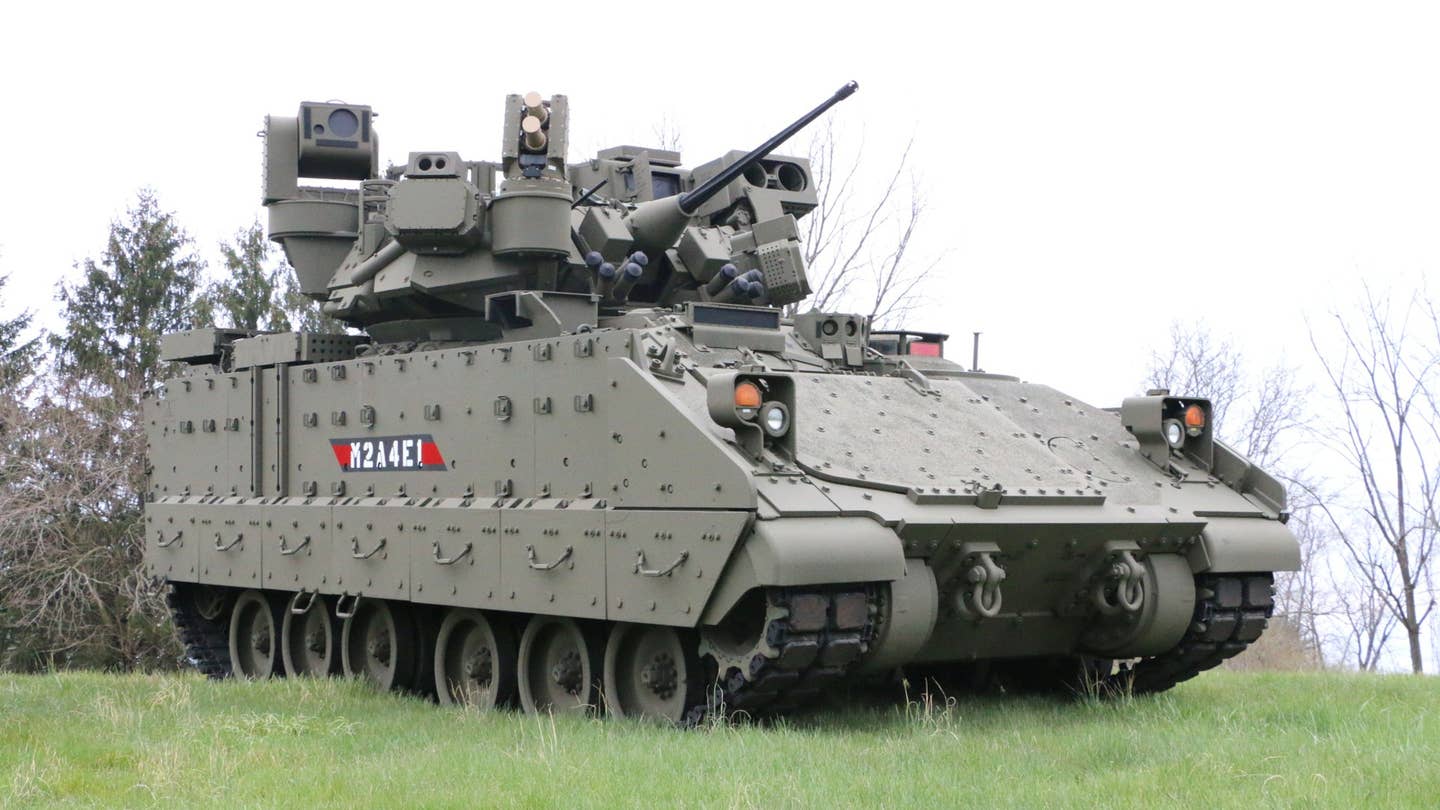This Is The Army’s New M2A4E1 Bradley That Features Iron Fist Protection
Hard-kill active protection systems offer valuable additional defense against missiles and rockets, and could be used to swat down drones.

The U.S. Army recently unveiled a new upgraded variant of the Bradley Fighting Vehicle. The M2A4E1 version most notably features the Israeli Iron Fist Light, a hard-kill active protection system designed primarily to physically destroy or at least disrupt incoming anti-tank guided missiles and other infantry anti-armor weapons like rocket-propelled grenades. This system could potentially also help defend against the growing threat posed by drones, as The War Zone has previously explored in detail.
The Army rolled out the M2A4E1 last week, according to recent social media posts from the service's Program Executive Office for Ground Combat Systems (PEO GCS). Army Maj. Gen. Glenn Dean, head of PEO GCS, had confirmed the service was starting to buy at least a limited number of Iron Fist systems from integration on Bradleys in an interview with Breaking Defense in March.
"The M2A4E1 is the most modern and survivable version of the Bradley as a result of integrating an Iron Fist Active Protection System," according to a post on PEO GCS's official Facebook page. The new variant also has and "improved High Definition Forward Looking Infrared Gunner’s Sight and an Environmental Control Unit to prevent heat stress for dismounts."
As installed on the M2A4E1, Iron Fist Light consists of two countermeasures launchers and four sensor arrays positioned around the vehicle's turret. The sensors, which are small form factor active electronically-scanned array (AESA) radars paired with infrared cameras, are used to detect and cue the launchers, which are turreted themselves. A small interceptor with a high-explosive fragmentation warhead is then fired at the incoming missile or rocket. Israel's Elbit Systems is the manufacturer of Iron Fist and U.S.-based General Dynamics Ordnance and Tactical Systems has been serving as the lead integrator of the system onto the Bradley.
The Army has been interested in adding an active protection system to the Bradley for years and has been looking closely at Iron Fist, specifically, for some time. A major hurdle in the past was the lack of necessary electrical power on earlier A3 variants to support the system. The M2A4 version, which the Army began fielding in 2022, features a new auxiliary power unit (APU) that has helped make the Iron Fist integration a reality.
The Iron Fist configuration on the M2A4E1 is also reportedly significantly different from previous iterations the Army has tested, but the specifics are unclear. A picture the Army previously released of a Bradley equipped with an Iron Fist did show a version of the system with a different type of radar.
PEO GCS has also said that funding to help replace dozens of older Bradleys transferred to Ukraine is aiding in the acquisition of M2A4E1 variants. It is unclear how many M2A4E1s the Army currently plans to acquire and how many of them will be converted from existing models.
The Army has been looking to add hard-kill active protection systems to other armored vehicles in inventory, as well. The service has been adding Trophy systems to its M1 Abrams tanks in recent years.
Trophy is another Israeli-made system from Rafael, which has been combat-proven in service with the Israel Defense Forces and that you can read more about in detail here. Companies in Israel have been and continue to be pioneers in the development of active protection systems.
The development and fielding of increasingly more capable anti-tank guided missiles and other infantry anti-armor weapons, including by near-peer competitors like China and Russia, has long been a driver for the adoption of active protection systems on armored vehicles by armed forces around the world. Those same kinds of anti-armor capabilities have also been increasingly proliferating among smaller countries and even non-state actors. The war in Ukraine, where U.S.-supplied Javelin anti-tank missiles and similar weapons have been a major factor in the fighting on both sides, has helped drive these concerns home.
Hard-kill active protection system may now offer a readily available way to give tanks and other armored vehicles extra protection against drones, something you can read about more in-depth in this past War Zone feature. The threats posed by uncrewed aerial systems, including highly maneuverable first-person view kamikaze types and other weaponized commercial designs, is not new. However, the conflict in Ukraine has again helped drive it into the mainstream consciousness.
The still-growing dangers that drones and anti-tank missiles, among other things, present to armored vehicles, in particular, have prompted experts working for the Army to question whether designs like the Abrams and the Bradley will still be dominant factors on high-end battlefields by 2040. The service is already looking at a future that features new lighter-weight crewed tanks and other armored vehicles, as well as multiple tiers of uncrewed ground combat vehicles.
In the meantime, adding active protection systems to platforms like the Bradley will be one of the ways to help ensure heavy armored vehicles remain relevant on future battlefields, at least under certain circumstances.
Contact the author: joe@twz.com



